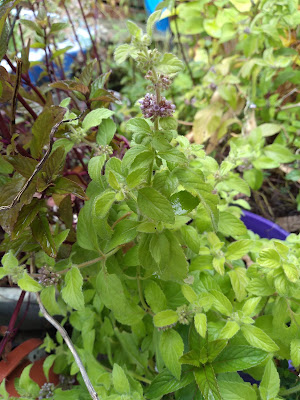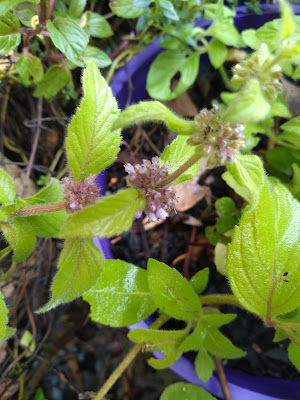I was given some seeds of a variegated tomato. They spent a while in the post, under who-knows -what conditions, so lost some viability.
Only 1 seed germinated and I have no way to get any more, so am really trying hard to save a lot of seed from this one plant.
The variegated tomato seedling grew like any other seedling, maybe a little slower, but not noticeably slower. When small they had very little variegation, as they got larger they got more variegated.
When my little seedling had a few true leaves I transplanted it into the vegetable garden.
 |
| Variegated tomato leaf |
 |
| Variegated tomato plant |
After transplanting this into the garden a bird came and stripped all its leaves as well as all the leaves from three nearby tomato plants of other varieties. I had a lot of trouble with birds this year. For some reason the birds wanted to defoliate all the plants at that end of my garden.
I caged the little tomato seedling stump, and for some time it did nothing. Eventually it grew one leaf, then after a very long time it started to grow again. As it grew I covered it and all my other tomato plants with bird netting to protect them.
After a while some tomatoes were getting too large and difficult to manage to keep under bird netting, so I removed the netting and hoped for the best. It appears that my variegated plant was large enough at that point because the birds left it alone.
 |
| Variegated tomato - red and round fruits |
 |
| Young plant starting to get variegation |
Variegated tomatoes are some of the most ornamental of tomato plants, even the stems are striped and interesting looking. I love ornamental looking vegetables because as well as looking attractive they also produce a crop of tomatoes.
The leaves are green, yellow, pink, and white.
 |
| Striped stems |
 |
| Variegation starts yellow, then turns white |
I have tried to do a little breeding to get the variegated trait into other tomatoes. It is far too early to tell how much success I had, and lots of generations before any new lines are stable.
I found it interesting that my variegated tomato produced lower leaves that were mostly green, and upper leaves were mostly white.
The tomatoes the variegated tomato plant produced are round and golf ball sized. Most were completely red, while a few had interesting stripes and swirls. Inside the tomatoes was mostly red with red/green pulp.
 |
| Variegated tomato - inside the fruit |
The variegated tomatoes taste sweet and nice. I don't know why, but I expected such an ornamental plant to have fruit that tasted sour or insipid, so the sweet taste was a nice surprise. While not as good tasting as some of the other varieties I grow, they taste far better than anything I have bought from the market. I think they are worth growing just for the tomatoes they produce, and the incredible variegated foliage is just a bonus.
I have started saving seed from these variegated tomatoes. I don't have any photos of the ripe fruit on my tomato plant, I plan to save every seed I can so have been picking them a little early and ripening them on the bench prior to saving seed.



















































